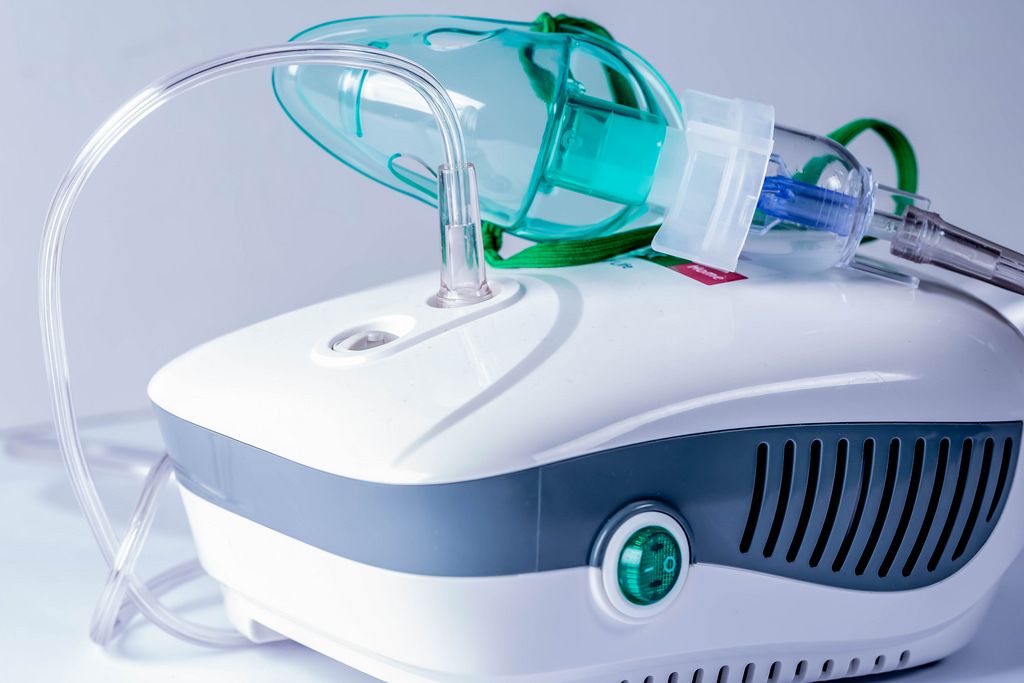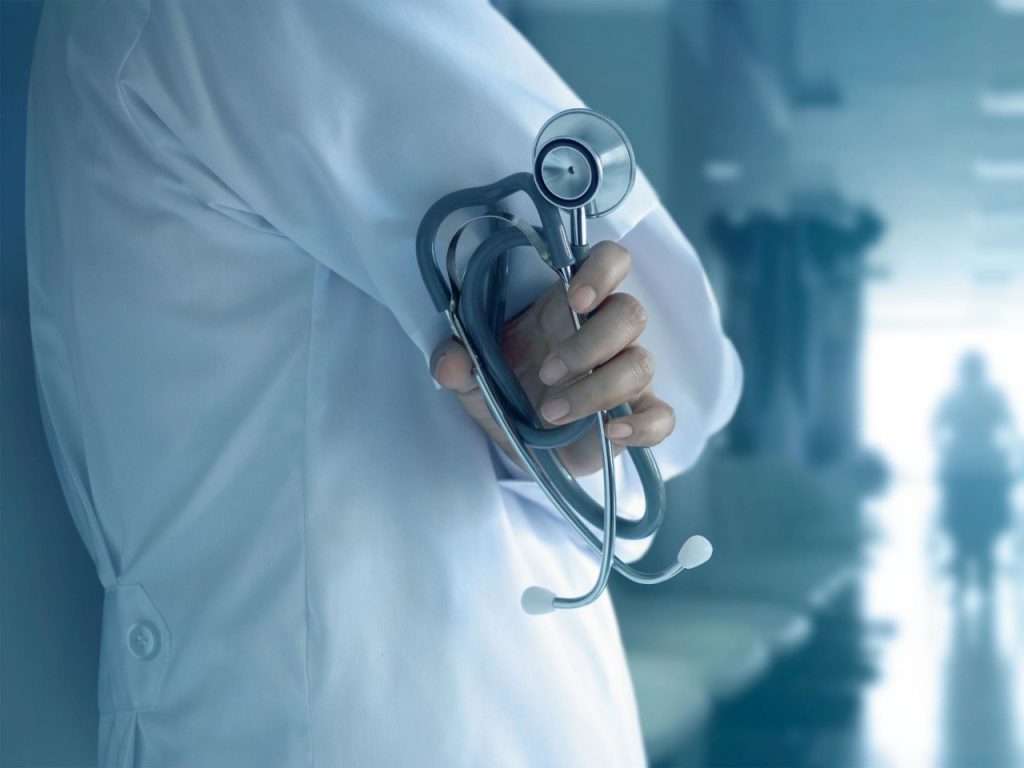What is a nebulizer?
Nebulizer is a device (machine)used to deliver medicine in the form of mist/air which is inhaled by the patient. It is different from a steaming device (steamer) which boils water and produces steam for inhalation.
What are the parts (components) of the nebulizer machine?
Nebulization system contains-
- Air compressor- this is the large box like part which runs on electricity and has a power cable attached to it. This part sucks air from the atmosphere and pushes the air out with force through a hole.
- Plastic pipe- it is a narrow pipe with 2 open ends, one end is attached to the hole delivering pressurized from the air compressor and the other end is attached to the nebulizer chamber.
- Nebulizer chamber- this is the main component of the nebulization system. It is here that the medicine for treatment is put which converts liquid into a mist. The medicine used for nebulization is in liquid form in plastic tubes called “Respule”. By twisting the tip of the respule, we can release the medicine which is added into the well of the nebulizer chamber. There is a small piece of plastic called a “baffle “inside the chamber which has to be placed in position in order to make the liquid into a mist. Do not lose the baffle, without it, mist is not generated.
Nebulizer chamber has markings on its wall, usually it is marked 2ml to 5ml or 2ml to 10ml. This marking is made to indicate the amount of liquid in the well of the chamber. If the liquid quantity is less than 2ml then, the mist generated is poor or there is no mist generated. So, if the volume of the liquid is < 2ml (usually prescribed for small children) then, distilled water or normal saline is added so that the quantity in the chamber is above 2ml.
- Interface- this is the final part in the circuit which is in contact with the human face or mouth. It is through the interface that the mist is finally made available for inhalation.
There are 2 types of interfaces-
a) Face mask- usually 2 sizes of face mask are provided, adult and pediatric.
b) Mouthpiece
Face mask is worn in such a way that it covers the mouth and the nose. It has holes on its sides to allow expired air to escape (air we breathe out); a metallic nose clip which is adjusted to make the mask fit snugly on the nose to prevent leakage of air and the mask has elastic string attached to it which is worn over the head. By pulling the strings from the sides one can make the mask fit snugly on the face.
Nebulizer Circuit: Air compressor→ Plastic pipe → Nebulizer chamber with the baffle → Interface (Mask or mouthpiece)
Nebulizer mask kit: contains Plastic pipe, nebulizer chamber and interface (Mask or mouthpiece)
Nebulizer machine (air compressor) is powered by electric current. Some portable devices are also available which are battery operated.
What is the difference between nebulizer and inhaler treatment?
Both the inhaler and the nebulizer serve the same purpose- deliver medicine into the lungs so that there is relief to the patient from breathlessness.
Inhaler treatment has some drawbacks:
- To use an inhaler effectively there are multiple steps involved in the process, steps which young children, old people and sick patients might find difficult to follow.
- Much of medicine is deposited on the tongue, throat or the palate if the inhaler is used directly without a spacer device, which can make inhaler treatment less effective.
- During an attack of asthma or a severe breathless episode, patients struggle to inhale from an inhaler as they are cannot manage to breathe in with sufficient force.
Nebulizer treatment overcomes these drawbacks and makes the delivery of medicine to the lungs more reliable. Patient has to breathe the medicine in the form of a mist and no special technique is required. There is no deposition of medicine over the tongue, throat or palate. Nebulization treatment is particularly effective in the treatment of young children, old patients and sick breathless patients. It Is the most effective way of delivering the inhalation medicine into the lungs.
Are there any side effects or complications due to nebulizer treatment?
The dose of medicine used in nebulization is higher than the dose in an inhaler. There is a good reason for this- during nebulization significant quantity of the medicine is wasted in the form of mist which escapes through the holes in the mask. However, delivery of medicine to lungs is much more effective compared to inhaler treatment. To compensate for such a loss of medicine the dose of medicine in a respule is comparatively more. So, the person using nebulization is ‘not’ deliberately exposed to high dose of medicine.
During inhalation of the mist from the nebulizer if the eyes get exposed to certain medicines, then, the pressure in the eye can increase which can create problems to patients with glaucoma (eye condition where the pressure inside the eye is high). To prevent such a risk, it is advisable to use a mouthpiece instead of face mask for inhalation or close the eyes during nebulization.
Compared to inhaler treatment the nebulization treatment is more expensive.
How does one use the nebulizer?
Please read the instructions given in the user manual of your nebulizer machine.
- assemble the nebulizer circuit first as described earlier
- connect the nebulizer machine (air compressor) to the power source
- twist the tip of the respule to open it and empty the liquid medicine into the well of the nebulizer chamber
- place the baffle inside the nebulizer chamber and lock the chamber with the cap
- connect the interface (face mask or mouthpiece) to the nebulizer chamber and wear the mask, pull the strings and adjust the nose clip over the nose so that there are no gaps through which the mist can escape
- switch on the nebulizer machine, you will see white color mist coming out of the interface.
- Inhale the mist as you normally breathe. It is not necessary that one needs to breathe fast or deep. You can hold your breath frequently (5 to 10 seconds if you can) during inhalation.
- Each nebulization treatment can last for 10 to 15 minutes. You will know that the liquid medicine is completely used up when you no longer see any mist generated and the nebulizer chamber is near empty or empty.
- Discard any remaining liquid in the nebulizer chamber, allow it to air dry and make sure that the entire circuit is dry before setting aside the device.
- It is advisable to gargle the throat and rinse the mouth with clean drinking water after completion of nebulization. This is done to prevent infections due to the medicine (containing steroid) deposited over the tongue, throat of palate (risk is less compared to inhaler treatment)
What are the Do’s and Don’ts in nebulization treatment?
Do’s
- Use the nebulization treatment regularly as advised by your doctor. Do not discontinue the treatment without your doctor’s approval. It is likely that your doctor may switch to inhaler treatment after you completed your nebulization treatment course.
- Follow the instructions given by the product user manual about details of the device you purchased.
- Clean the parts of the nebulizer circuit on a daily basis using mild detergent or mild antiseptic, make sure you rinse the part with clean water after washing and allow to air dry.
- Check for the clogging of the air filter provided in the air compressor machine. Replace the filter on a regular basis for better performance. If you are using the nebulizer daily then it is possible the filter needs to be changed once every 1-2 months.
- Replace the plastic pipe if you see staining on the inner lining of the pipe and also if the nebulizer has not been used for few days. If water or medicine remains in the circuit after use and if nebulizer is unused for few days, bacterial or viral infections risk increases.
- Always keep the nebulizer on a flat surface. Make sure the nebulizer chamber and the mask is held upright all the time (perpendicular to the ground). If the nebulizer chamber is not upright or held horizontal then the chamber will fail to generate adequate mist of the medicine in the chamber.
- If you suffer from an eye condition called “glaucoma” you should inform the same to your doctor. Some medicines used for nebulization may aggravate glaucoma hence your doctor can help if informed.
- If the mist generated is poor or the nebulizer machine is making lot of noise then you should get the machine checked soon. Remember nebulizer machine needs periodic checks and regular maintenance. Sometimes, if the nebulizer is not working well then, it takes long time to complete the nebulization (usual time for each nebulization is 10-15 mins)
Don’ts
- Store the nebulizer and its components in a clean and closed environment.
- If you have not used the nebulizer for few weeks then do not use the device straight away without cleaning and disinfecting the components.
- Do not breathe heavily when using the nebulizer, it does not help give you more medicine. Breathe normally as you usually do, through the nose. There is no need to change the way you breathe while using the nebulizer. Remember, there will be wastage of the medicine through mist escaping from the holes of the mask.
- Do not leave any remnants of the medicine in the nebulizer chamber. If any liquid medicine is remaining, then, discard it. Remember it is important to keep the nebulizer circuit dry at all times.
- Do not use the same nebulizer kit for many persons. It is advisable to use separate nebulizer kit for an individual and not share the mask, nebulizer pipe and nebulizer chamber (nebulizer kit). You can however use the nebulizer machine (air compressor) for multiple users.
- Do not use a cloth to clean the inner surface of the nebulizer chamber. Allow the chamber to air dry by itself. If a cloth is used, it can cause fine scratches and medicine tends to stick to this while using the nebulizer.
- If you are not going to use the nebulizer for sometime then, clean and disinfect all the components, allow to dry and store the clean device in a clean, dry and enclosed box.
If you are not sure of how to use the nebulizer or have doubts about its performance, please get in touch with a technician/bio-medical person or consult your doctor.



